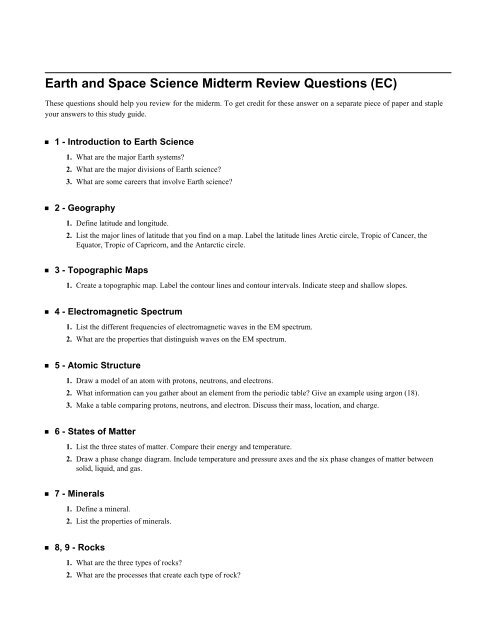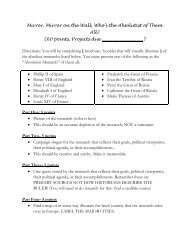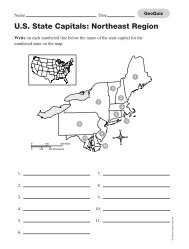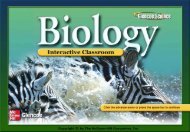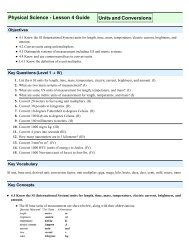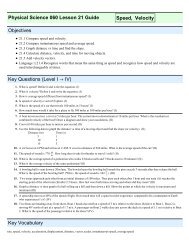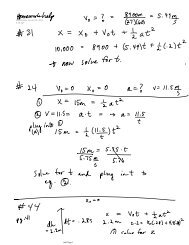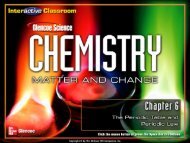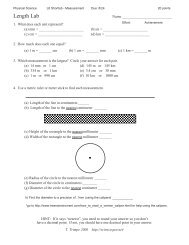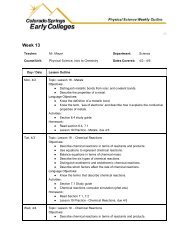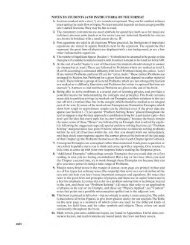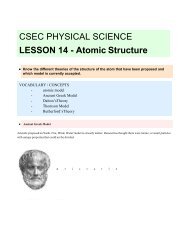Earth and Space Science Midterm Review Questions (EC)
Earth and Space Science Midterm Review Questions (EC)
Earth and Space Science Midterm Review Questions (EC)
You also want an ePaper? Increase the reach of your titles
YUMPU automatically turns print PDFs into web optimized ePapers that Google loves.
<strong>Earth</strong> <strong>and</strong> <strong>Space</strong> <strong>Science</strong> <strong>Midterm</strong> <strong>Review</strong> <strong>Questions</strong> (<strong>EC</strong>)These questions should help you review for the miderm. To get credit for these answer on a separate piece of paper <strong>and</strong> stapleyour answers to this study guide. 1 - Introduction to <strong>Earth</strong> <strong>Science</strong>1. What are the major <strong>Earth</strong> systems?2. What are the major divisions of <strong>Earth</strong> science?3. What are some careers that involve <strong>Earth</strong> science? 2 - Geography1. Define latitude <strong>and</strong> longitude.2. List the major lines of latitude that you find on a map. Label the latitude lines Arctic circle, Tropic of Cancer, theEquator, Tropic of Capricorn, <strong>and</strong> the Antarctic circle. 3 - Topographic Maps1. Create a topographic map. Label the contour lines <strong>and</strong> contour intervals. Indicate steep <strong>and</strong> shallow slopes. 4 - Electromagnetic Spectrum1. List the different frequencies of electromagnetic waves in the EM spectrum.2. What are the properties that distinguish waves on the EM spectrum. 5 - Atomic Structure1. Draw a model of an atom with protons, neutrons, <strong>and</strong> electrons.2. What information can you gather about an element from the periodic table? Give an example using argon (18).3. Make a table comparing protons, neutrons, <strong>and</strong> electron. Discuss their mass, location, <strong>and</strong> charge. 6 - States of Matter1. List the three states of matter. Compare their energy <strong>and</strong> temperature.2. Draw a phase change diagram. Include temperature <strong>and</strong> pressure axes <strong>and</strong> the six phase changes of matter betweensolid, liquid, <strong>and</strong> gas. 7 - Minerals1. Define a mineral.2. List the properties of minerals. 8, 9 - Rocks1. What are the three types of rocks?2. What are the processes that create each type of rock?
2 ess_midterm_review.nb3. Draw the rock cycle.4. Describe the process of lithification.5. What regions would be likely to experience metamorphism? 10 - Weathering, Erosion, <strong>and</strong> Soil1. Define weathering <strong>and</strong> erosion. How are they different?2. What are the three main components of soil?3. How does soil type affect erosion?4. Describe components of mechanical <strong>and</strong> chemical weathering. How do they differ? 11 - Mass Movements1. What are the main types of mass movements?2. What is the underlying force behind all mass movements? 12 - Wind Erosion1. Describe evidence of wind erosion.2. What features are formed by wind erosion?3. What factors increase the effects of wind erosion? 13 - Glaciers1. Name features of erosion that can be attributed to glaciers.2. How are glaciers formed? 14 - Surface Water1. Name features of rivers, lakes <strong>and</strong> wetl<strong>and</strong>s.2. What factors affect the rate of runoff?3. What is the process of eutrophication? 15 - Ground Water1. Describe how groundwater is stored <strong>and</strong> how it moves underground.2. How much water on the <strong>Earth</strong> is fresh water? Draw the distribution of water.3. Describe the major problems that threaten groundwater supplies.


